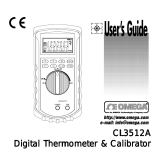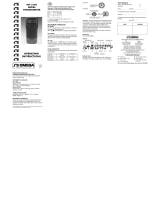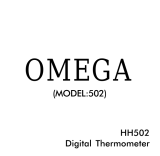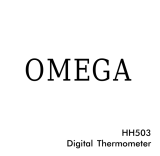
MADE IN
TEMPERATURE INDICATOR
HOLD
ON
°F
1°
0.1°
OFF
ON
°C
305.4
°F
THERMOCOUPLE THERMOMETER
TYPE E
450 AET
®

Servicing North America:
USA: One Omega Drive, Box 4047
ISO 9001
Stamford CT 06907-0047
Cer
tified Tel: (203) 359-1660 FAX: (203) 359-7700
e-mail: [email protected]
Canada: 976 Bergar
Laval (Quebec) H7L 5A1, Canada
Tel: (514) 856-6928 FAX: (514) 856-6886
e-mail: [email protected]
For immediate technical or application assistance:
USA and Sales Service: 1-800-826-6342 / 1-800-TC-OMEGA
®
Canada: Customer Service: 1-800-622-2378 / 1-800-622-BEST
®
Engineering Service: 1-800-872-9436 / 1-800-USA-WHEN
®
TELEX: 996404 EASYLINK: 62968934 CABLE: OMEGA
Mexico: En Espan˜ol: (001) 203-359-7803
FAX: (001) 203-359-780
e-mail: [email protected]
OMEGAnet
®
On-Line Service Internet e-mail
www.omega.com [email protected]

Benelux:
Postbus 8034, 1180 LA Amstelveen
The Netherlands
Tel: +31 (0)20 3472121 FAX: +31 (0)20 6434643
Toll Free in Benelux: 0800 0993344
e-mail: [email protected]
Czech Republic:
Frystatska 184, 733 01 Karvina´, Czech Republic
Tel: +420 (0)59 6311899 FAX: +420 (0)59 6311114
Toll Free: 0800-1-66342
e-mail: [email protected]
France:
11, rue Jacques Cartier
78280 Guyancourt, France
Tel: +33 (0)1 61 37 2900 FAX: +33 (0)1 30 57 5427
Toll Free in France: 0800 466 342
e-mail: [email protected]
Servicing Europe:
Germany/Austria:
Daimlerstrasse 26, D-75392
Deckenpfronn, Germany
Tel: +49 (0)7056 9398-0
FAX: +49 (0)7056 9398-29
Toll Free in Germany: 0800 639 7678
e-mail: [email protected]
United Kingdom: ISO 9002 Certified
One Omega Drive
River Bend Technology Centre
Northbank, Irlam, Manchester
M44 5BD United Kingdom
Tel: +44 (0)161 777 6611
FAX: +44 (0)161 777 6622
Toll Free in United Kingdom:0800-488-488
e-mail: [email protected]
It is the policy of OMEGA to comply with all worldwide safety and EMC/EMI regulations that apply.
OMEGA is constantly pursuing certification of its products to the European New Approach
Directives. OMEGA will add the CE mark to every appropriate device upon certification.
The information contained in this document is believed to be correct, but OMEGA Engineering,
Inc. accepts no liability for any errors it contains, and reserves the right to alter specifications
without notice. WARNING: These products are not designed for use in, and should not be used
for, human applications.
RETURN REQUESTS/INQUIRIES
Direct all warranty and repair requests/inquiries to the OMEGA Customer Service
Department. BEFORE RETURNING ANY PRODUCT(S) TO OMEGA, PURCHASER
MUST OBTAIN AN AUTHORIZED RETURN (AR) NUMBER FROM OMEGA’S
CUSTOMER SERVICE DEPARTMENT (IN ORDER TO AVOID PROCESSING DELAYS).
The assigned AR number should then be marked on the outside of the return
package and on any correspondence.
The purchaser is responsible for shipping charges, freight, insurance and proper
packaging to prevent breakage in transit.
FOR WARRANTY RETURNS, please
have the following information
available BEFORE contacting OMEGA:
1. Purchase Order number under which
the product was PURCHASED,
2. Model and serial number of the
product under warranty, and
3. Repair instructions and/or specific
problems relative to the product.
FOR NON-WARRANTY REPAIRS,
consult
OMEGA for current repair charges. Have the
following information available BEFORE con-
tacting OMEGA:
1. Purchase Order number to cover the COST
of the repair,
2. Model and serial number of the product, and
3. Repair instructions and/or specific problems
relative to the product.
OMEGA’s policy is to make running changes, not model changes, whenever an improve-
ment is possible. This affords our customers the latest in technology and engineering.
OMEGA is a registered trademark of OMEGA ENGINEERING, INC.
© Copyright 2003 OMEGA ENGINEERING, INC. All rights reserved. This document may not
be copied, photocopied, reproduced, translated, or reduced to any electronic medium or
machine-readable form, in whole or in part, without the prior written consent of OMEGA
ENGINEERING, INC.

Table of Contents
Section 1: Description
1.1 General Description……………2
1.2 Physical Description…………...3
1.3 Unpacking………………………3
1.4 Specification…………………… 4
Section 2: Operation
2.1 Principles of Operation………...7
2.2 Power…………………………… 8
2.3 Operation……………………….10
2.4 Maintenance……………………13
Section 3: Calibration
3.1 Calibration………………………14

2
Section 1 Description
1.1 General Description
Your hand-held, battery operated digital
temperature indicator is configured for compatibility
with one of five temperature transducers, J,K,E,T
RTD and Thermister.
Each of the configurations linearizes the analog
output from the transducer to produce a stable and
accurate digital temperature display. Plug-in type
input connectors are used for the transducer input
to provide quick connect and disconnect capability.
The indicator functions are controlled by the key-
board. The liquid crystal display exhibits the value
of the measurement, degrees Fahrenheit or Celsius,
and the low battery voltage indication.
The use of advanced digital design techniques
give the indicator extremely accurate readings and
exceptionally long battery life.

3
1.2 Physical Description
The indicator measures 45 mm (1.8 inches) in
Height, 85 mm (3.3 inches) in width, and 145 mm
(5.7 inches) in length. Weight is 230 grams (8.0
ounces). The case is constructed of high impact
plastic.
1.3 Unpacking
The indicator is supplied with the battery installed.
A quick electrical test should be performed to verify
that the indicator is operative. See 2.3 in Section 2
for operating instructions.
Contact our Instrument Repair Department
immediately if any problems are observed after
checking out operation of the unit.

4
Specifications
Display:
Liquid crystal display, 7.6 mm (0.3 in.) digit
Height
Operating temperature:
0 to 50°C (32 to 122°F) 0 to 75% Relative
Humidity
Storage Temperature:
-20 to 70°C (-4 to 158°F)
Battery:
NEDA 1604, 9 Volt
Battery Life:
Thermocouple-2000 hours minimum
Platinum RTD-500 hours minimum
Thermistor- 1200 hours minimum
NMRR:
50 dB @ 50±1 Hz, 0.1° range
35 dB @ 50±1 Hz or 60±1Hz, 1° range
CMRR:
140 dB @ 50±1 Hz, 0.1° range
120 dB @ 50±1 Hz or 60±1Hz, 1° range

5
Maximum Common Mode Voltage:
1000VAC(RMS), ±2000V Peak
Accuracy at 22°C (72°F)
1° range: ±0.8°C±0.1% rdg
±1.5°F±0.1% rdg
0.1° range: ±0.25°C±0.1% rdg
±.45°F±0.1% rdg
Stability with time:
90 days: add ±0.05% rdg.
1 year: add ± 0.1% rdg.
Stability with temperature:
Thermocouple:
zero: ±0.03°C/°C
span: ±0.02% rdg/°C (max)
reference junction tracking ±1.0°C (±1.8°F)
from 5°C to 45°C (41°F to 113°F)
Platinum RTD: ±0.02°C, ±0.01% rdg/°C
Thermistor: positive- ±0.02°C/°C
negative-±0.04°C/°C

6
450 Range Table
Type
K
Type
J
Type
E
Type
T
1
0.1
1
0.1
1
0.1
-189 C to +1372 C
-308 F to +2501 F
-139.8 C to +203.7 C
-219.7 F to +398.7 F
-194 C to +1200 C
-318 F to +2192 F
-117.4 C to +203.5 C
-179.4 F to +398.7 F
-212 C to +1000 C
-351 F to +1832 F
-137.2 C to +203.5 C
-215.0 F to +398.4 F
-217 C to +400 C
-360 F to +752 F
-148.2 C to +203.9 C
-234.8 F to +399.0 F
-233 C to +904 C
-388 F to +1660 F
-102.9 C to +203.5 C
-153.2 F to +398.3 F
-25.7 C to +103.2 C
-14.4 F to +217.8 F
1
0.1
0.1
1
0.1
RTD
Thermister

7
Section 2 Operation
2.1 Principles of Operation
The temperature indicator uses two ICs to digitize
and display the analog input signal.
One IC performs the conversion of the analog
input to the digital equivalent via 24 bit delta-
sigma analog to digital converter. Battery voltage
is also monitored by this IC and a thermistor
supplies the reference junction correction signal.
The other IC receives input from the analog
to digital converter, linearizes and drives the
LCD display. Front panel buttons are also
monitored.

8
2.2 Power
When battery voltage reaches about 6 volts, the
display will exhibit a flashing: “LOW BAT” indication.
A minimum of 20 hours of operation time remains
upon initial appearance of the “LOW BAT” indication.
When the battery voltage drops below 5 volts, an
overload indications of three columns of dashes will
appear on the display in addition to the flashing
“LOW BAT” symbol.
The indicator uses a NEDA 1604 (or equivalent) 9
Volt battery. The battery will provide a minimum of
2000 hours of continuous thermocouple operation,
500 hours of RTD operation, or 1200 hours of
thermistor operation. To replace the battery, follow
these steps.
Note: The indicator must be OFF when
Replacing the battery.
Step 1: Place the indicator face down on a flat
surface and remove the four screws located in

9
the recesses or each corner of the case bottom.
Step 2: Carefully pull the case halves straight
apart so as not to damage the internal connectors.
Step 3. Install the new battery. Close the case and
reinstall the four screws.

10
2.3 Operation
Step 1: Insert temperature sensor plug into the
indicator input jack. Failure to insert a probe results
in a overload condition of three columns of dashes
showing on the display.
Step 2: Turn the indicator ON by pressing the °F
or °C key. The display can be switched to read the
temperature in degrees Celsius or Fahrenheit
without affecting calibration.
Step 3: Select the display range of 1° (wide range,
low resolution) or 0.1° (narrow range, high
resolution) with the 1°/0.1° key.
Note: The thermistor unit has
a fixed resolution of 0.1°.
Step 4: By pressing and holding the HOLD key,
The last reading will be displayed as long as the
hold key is depressed. After the hold key is released,
the indicator will revert to its normal display mode.

11
Step 5: Observe and or record the temperature
value.
Step 6: Turn instrument off by pressing the OFF
key.

12
450 SERIES
OFF
HOLD
ON
F
.
ON
C
.
1
0.1
F
C
F/C
Indication
Display
Value
Probe
Input Jack
Low
Battery
Voltage
Indication
To Hold
Display
Press and
hold key to
retain last
reading on
the display.
Press this
key to
turn OFF
Range Selector
Press C or F keys to
turn ON and/or
temperature scale
Operation Features

13
2.4 Maintenance
Normal maintenance of the indicator consists of
occasional cleaning with a soft, damp cloth,
replacement of the battery as required, and
calibration as outlined in Section 3.

14
Section 3 Calibration
3.1 Calibration
Units with serial numbers beginning with the
letter N use the calibration procedure outlined
below. Older units do not display version
numbers and use the calibration procedures
on page 19 .
The calibration procedure should be performed
by a qualified instrumentation service technician.
The indicator may be brought to any instrumentation
calibration and repair laboratory (metrology lab) for
the service (this manual should accompany the
instrument). This procedure should be done at least
once a year to guarantee continued performance
within the specification.
The instrument should be calibrated at an ambient
temperature of 22° C with a thermocouple simulator

15
with a minimum accuracy of ±0.1 degree
Fahrenheit or ±0.2 degree Centigrade.
Step 1. Ensure the unit is turned off. Connect the
output of the thermocouple simulator to the input
of the indicator using the appropriate
thermocouple wire. Set the simulator output to 0°C
Step 2. Locate the calibration switch on the back
of the case labeled “Zero”. Remove the black
button. Using a small screw drive or flat end of the
trimmer pot, press the cal switch once. The display
should read version and then switch to ambient
temperature; press the switch one more time. The
display should indicate .0.0 °C
Step 3. Press the switch one more time, the
display should read max calibration temperature
(for K type: 13.2.0, for J type: 9.6.0, for T type:
3.5.0, and for E type: 9.5.0) Now, set the simulator
output to display temperature as show in table
below.

16
NOTE: If you want to cancel the calibration
mode press OFF button in front of the unit.
For T/C type K set simulator @ 1320 °C
J set simulator @ 960 °C
T set simulator @ 350 °C
E set simulator @ 950 °C
Press the switch one more time and wait for a few
seconds until display switches to 0.0 set simulator
to 0°C. Press switch one more time. Unit should
shut-off.
Step 4. Now, turn the unit on from front panel.
Make sure the unit in degree C mode. Verify that
the unit is within specification throughout its range.
Step 5. If unit does not meet specification as 0°C
then repeat calibration procedure,
Instead of setting simulator as 0°C, set it at the
temperature indicated by the unit in measurement
mode as 0°C. For example in measure mode, unit
may display .2°C with simulator as 0°C. During

17
calibration procedure, set simulator at .2°C instead
of 0 °C. Repeat the calibration procedure again.
Step 6. Verify calibration once finished.
Page is loading ...
Page is loading ...
Page is loading ...
Page is loading ...
Page is loading ...
Page is loading ...
Page is loading ...
Page is loading ...
Page is loading ...
Page is loading ...
Page is loading ...
-
 1
1
-
 2
2
-
 3
3
-
 4
4
-
 5
5
-
 6
6
-
 7
7
-
 8
8
-
 9
9
-
 10
10
-
 11
11
-
 12
12
-
 13
13
-
 14
14
-
 15
15
-
 16
16
-
 17
17
-
 18
18
-
 19
19
-
 20
20
-
 21
21
-
 22
22
-
 23
23
-
 24
24
-
 25
25
-
 26
26
-
 27
27
-
 28
28
-
 29
29
-
 30
30
-
 31
31
Omega 450 SERIES User manual
- Type
- User manual
- This manual is also suitable for
Ask a question and I''ll find the answer in the document
Finding information in a document is now easier with AI
Related papers
Other documents
-
 Omega Vehicle Security CL3512A User manual
Omega Vehicle Security CL3512A User manual
-
 Omega Vehicle Security HH2100 Series User manual
Omega Vehicle Security HH2100 Series User manual
-
Dwyer CA10 User manual
-
 Omega Vehicle Security HH502 User manual
Omega Vehicle Security HH502 User manual
-
 Omega Vehicle Security HH503 User manual
Omega Vehicle Security HH503 User manual
-
Benchmark Scientific BMS-B2000-4 Owner's manual
-
Omega Speaker Systems DRX-RTD User manual
-
ETS 872 User manual
-
Simpson Mini-Max series User manual
-
Benchmark Scientific B2000-12 Owner's manual


































